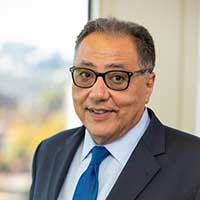By Hafez Ghanem
PARIS, Apr 22 2024 – The world is facing multiple crises that must be tackled quickly, with innovative approaches and brave decisions. The global financial architecture is an area that needs reform and thinking outside the box. The system created 80 years ago is not able to deal with today’s problems that range from climate change to pandemics, to increasing inequality, to conflict and fragility, to food insecurity and poverty.

Hafez Ghanem
The climate battle is being lost and the world is failing to achieve the Paris Agreement’s goal of maintaining global warming at below 1.5°C. It is also off track for reaching the Sustainable Development Goals (SDGs). To achieve the goals of the Paris Agreement as well as the SDGs, the whole world (especially EMDEs) will need to accelerate investments for climate and for development. This represents a huge financing challenge for EMDEs (excluding China). According to the Independent High Level Expert Group on Climate Finance they will need to invest $2.4 trillion a year by 2030 just for climate action, with total investments being around $5.4 trillion of which $1trillion will have to be externally financed.
The current global financial architecture is not delivering for the EMDEs: official development assistance (ODA) is too low, net private capital flows are negative, and EMDEs are facing debt sustainability problems. According to the Organization for Economic Cooperation and Development (OECD) ODA in 2022 was $204 billion, nowhere near the trillion that is needed. Moreover, the $204 billion figure includes in-donor refugee costs of $29.3 billion and assistance to Ukraine of $16.1 billion. That is, actual ODA to the EMDEs, the so-called country programmable aid, was much less than $200 billion. At the same time, private capital is leaving EMDEs. Calculations by Kharas and Rivard (2024) show that in 2022 net private capital flows to EMDEs was minus $125 billion and that negative figure increased to minus $193 billion in 2023. This is happening in the face of rising sovereign debt problems. According to the World Bank about half of the world’s poorest countries are either in debt distress or are at high risk of debt distress. In some countries debt service costs are higher than the budgets for health and education.
In view of this situation the United Nation’s Secretary General, (SG) (as well as many voices in the Global South) is calling for reforms of multilateralism including the global financial architecture. The UN is organizing a Summit of the Future in September 2024 to discuss possible reforms and has issued a report entitled our Common Agenda with a companion policy brief on reforms of the global financial architecture. The Global Economy program at the Brookings Institution organized a series of roundtables to discuss the UN proposals, and issued its own report with a series of recommendations for reforming the global financial architecture. The recommendations cover: (1) the system’s governance, (2) increasing financing for climate and development and dealing with unsustainable debt; (3) expanding the global financial safety net; and (4) reforming the international tax system. In the remainder in this blog, I shall summarize some of the recommendations pertaining to increasing financing for climate and the SDGs.
The first set of reforms to be considered concern increasing the lending capacity of the Multilateral Development Banks (MDBs). The G20 has been very active in this area and has supported several studies, the most recent ones are: a 2022 independent review of Multilateral Development Banks (MDBs) capital adequacy frameworks (CAF); a 2023 report on further MDBs reforms titled “The Triple Agenda”; and finally also in 2023 a Roadmap for the Implementation of the CAF Report. Implementation of the recommendations on the capital adequacy frameworks would increase MDBs lending capacity by $196.5 billion and are on the road to implementation. In addition to those reforms, it will be necessary to increase the capital of the MDBs.
The G20 has called for a recycling of $100 billion equivalent of the IMF’s Special Drawing Rights (SDRs) to EMDEs through the MDBs. In 2021 the Fund injected $650 billion worth of SDRs into the world economy to help countries deal with the economic fallout from the pandemic. Countries received SDRs in proportion to their IMF quotas. Thus, according to Georgieva et al (2023) rich countries, who already had sufficient reserves received $350 billions of additional liquidity which they did not need ;and therefore it sits “dormant”. An initial recycling of SDRs has occurred through the IMF’s Poverty Reduction and Growth Trust (PRGT) and the Resilience and Sustainability Trust (RST). But so far, no recycling has been done through the MDBs; even though (unlike the PRGT and the RST) the MDBs are able to leverage the recycled SDRs. Using the ratios in the G20’s Triple Agenda Report recycling $100 billion of SDRs as hybrid MDB capital would raise a total of $1.5 trillion of additional financing, $700 billion in direct lending and $800 billion in indirect private financing.
Increasing the lending capacity of the MDBs is important but will not be enough to meet all the financing requirements for climate action. There is a need to distinguish between climate investments that are national public goods (adaptation and loss and damage estimated to require $600 billion/year) that are also mostly financed by public resources; and mitigation which is a global public good that should be mostly financed by the private sector. Mitigation is estimated to require about $1.8 trillion/year; about 1.5 trillion for the energy transition and $300 billion for agriculture and natural capital. The existing system of MDBs could handle adaptation and loss and damage. But, as suggested by Ghanem (2023) a new institution, a Green Bank, which could be completely independent or could be part of the World Bank Group, is needed to finance mitigation. Green Bank would be different from existing MDBs because it would be a public-private partnership with private shareholders participating in its funding and governance. Moreover, it would only finance (through equity and loans) private sector climate mitigation projects.
There are many proposed reforms of the global financial architecture that are being discussed and debated. In this short blog I chose to focus on those that aim at increasing the system’s ability to finance climate and development. These are key challenges that currently the international financial system appears unable to adequately address. Among the reforms presented here there is a consensus on the need to implement the CAF recommendations and they appear on their way. There is still resistance to the idea of recycling “dormant” SDRs through the MDBs and a decision on this issue has been postponed several times. The Green Bank proposal has not yet gained much traction as many people worry about the creation of another international organization. I would like to point out, though, that there are currently 62 multilateral climate funds that are only disbursing 3-4 billion dollars a year and that are not well coordinated. It would make sense to close most of those funds and replace them by one Green Bank that could mobilize private support and the trillions needed and be accountable for results.
Hafez Ghanem, a former World Bank Vice President for Africa, is a non-resident senior fellow in the Global Economy and Development Program at the Brookings Institution and senior fellow at the Policy Centre for the New South.
IPS UN Bureau


No comments yet... Be the first to leave a reply!